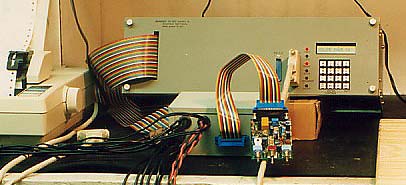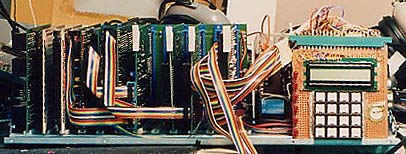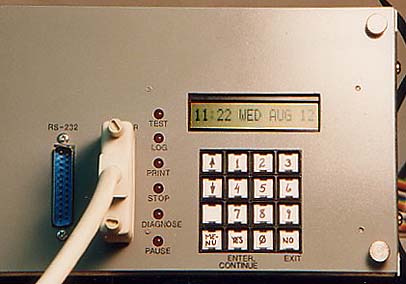|
6502-based ATE Pages: Project Description  This is a 6502-controlled automated test equipment (ATE) setup I made and
programmed at my last place of work in about 1990. It is shown testing one
of the products on a board of about 2.25" x 4.5" near the front edge of the
workbench. This setup is much more compact than previous ones I had done
which used some high-doallar Hewlett-Packard and other IEEE-488 equipment
stacked in a 19" rack. This new setup had signal generators, DMM, loads,
amplifiers, power supplies, switching matrices, etc.. in a 3U 19" rack
cabinet. It's all controlled by a Cubit 6502 SBC running Forth. The
program was about 10,000 lines of compact code. It would do scores of tests
on dozens of different models of the products, yet the program and all test
parameters compiled to about 38KB with Forth headers (or about 28KB
without). This project is what really got me going in Forth on the 6502.
Using Forth, I was able to spend my time figuring out hardware problems
instead of debugging software. (Forth does make hardware problems easier to
figure out.) After I released the ATE to the production floor for everyday
use, no one ever found any bugs in it. I know they used it for at least 8
years after I made it, and they may still be using it today. They paid me
to service it a few times after I left the company, for things like an IC or
relay that went south, or a cable that became undependable from being flexed
tens of thousands of times.
This is a 6502-controlled automated test equipment (ATE) setup I made and
programmed at my last place of work in about 1990. It is shown testing one
of the products on a board of about 2.25" x 4.5" near the front edge of the
workbench. This setup is much more compact than previous ones I had done
which used some high-doallar Hewlett-Packard and other IEEE-488 equipment
stacked in a 19" rack. This new setup had signal generators, DMM, loads,
amplifiers, power supplies, switching matrices, etc.. in a 3U 19" rack
cabinet. It's all controlled by a Cubit 6502 SBC running Forth. The
program was about 10,000 lines of compact code. It would do scores of tests
on dozens of different models of the products, yet the program and all test
parameters compiled to about 38KB with Forth headers (or about 28KB
without). This project is what really got me going in Forth on the 6502.
Using Forth, I was able to spend my time figuring out hardware problems
instead of debugging software. (Forth does make hardware problems easier to
figure out.) After I released the ATE to the production floor for everyday
use, no one ever found any bugs in it. I know they used it for at least 8
years after I made it, and they may still be using it today. They paid me
to service it a few times after I left the company, for things like an IC or
relay that went south, or a cable that became undependable from being flexed
tens of thousands of times.
 Same ATE, with the case open, during development. I made two sets. The
original plan was for up to seven, but that became unnecessary. This used
STD bus (which, BTW, stands for "simple to design," not "standard.") The
boards are about 4.5 x 6.5", with 56 contacts at the edge connector.
Same ATE, with the case open, during development. I made two sets. The
original plan was for up to seven, but that became unnecessary. This used
STD bus (which, BTW, stands for "simple to design," not "standard.") The
boards are about 4.5 x 6.5", with 56 contacts at the edge connector.
 A close-up of the operator interface. With the earlier setup using the
HP-9000-series computer, the test operator had a large screen and keyboard,
which proved troublesome. The idea here was to only give the operator
access to what (s)he needed to do. As it turned out, it would have been
nice to have the LCD a little bigger than 16-character, 1-line-- maybe a
40x2. It fit the bill pretty well though. Failing test results always got
printed out so the paper would get rubber-banded to the unit to go back to
repair. Optionally, all test results could be printed, or archived for
later download to a PC to analyze with something like Lotus 1-2-3.
A close-up of the operator interface. With the earlier setup using the
HP-9000-series computer, the test operator had a large screen and keyboard,
which proved troublesome. The idea here was to only give the operator
access to what (s)he needed to do. As it turned out, it would have been
nice to have the LCD a little bigger than 16-character, 1-line-- maybe a
40x2. It fit the bill pretty well though. Failing test results always got
printed out so the paper would get rubber-banded to the unit to go back to
repair. Optionally, all test results could be printed, or archived for
later download to a PC to analyze with something like Lotus 1-2-3.
|



